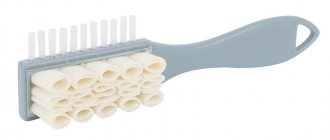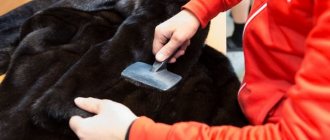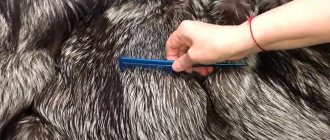A fur coat is a regal piece of clothing that is the ultimate dream for many of the fair sex. But it should be remembered that the end of the hassle of purchasing a fur beauty means the emergence of new ones related to preserving the beauty of your fur coat and increasing its service life, so our article is about how to properly store a mink coat in the summer at homewithout turning to specialists.
The most important point that you should know about and pay proper attention to is storing fur products at home. Not only the lifespan of fur, but also the preservation of its pristine beauty and majestic luxury directly depends on this.
Winter: wearing rules...
Mink is capricious to wear and does not tolerate neglect. For a fur coat to remain beautiful for more than one season, it must be worn correctly. And here’s what you should pay attention to before “walking” your pet.
- Freezing. Mink loves low temperatures. Therefore, a frosty day is a great reason to take a walk in your favorite fur outfit.
- Sun. Bright sun causes the color to fade. It should be avoided so that the fur does not lose its luxurious color.
- Moisture. What happens to your hair after it rains? Same as with fur. If you suddenly get caught in wet snow, get to a warm room as soon as possible, shake off the moisture and dry your fur coat at room temperature. You can’t use a hairdryer - it will dry out the pile and leather fabric.
- Dust. Dust settles on the hairs, gets clogged into the pores of the leather fabric - the fur coat quickly loses its luster and looks untidy. If it’s already frosty, but there’s not enough snow outside, and the wind raises clouds of dust, leave your fur coat at home until better times.
- Friction. It is a nightmare for a fur coat. Even with slight but prolonged pressure, the fur wrinkles. And with constant friction, it’s even worse: the guard hair breaks, the underhair gets wiped out, and ugly bald patches appear. Therefore: we carry bags exclusively in our hands and diligently avoid crowds.
- Reagents. Mink fur is very delicate and does not tolerate exposure to aggressive substances. It is better not to walk along streets treated with reagents in a long fur coat: the route should be from the entrance to the transport and back.
Which case to choose
A fur item definitely needs a cover, especially if there are several coats with dyed fur nearby.
- To ensure air access to the fur coat, the cover should be chosen from natural fabric (linen, cotton, canvas).
- It is impossible to keep a fur item in a hermetically sealed polyethylene bag due to the formation of condensation.
- Storing a fur coat in a vacuum bag is unacceptable for several reasons. Finding a package of the required size is quite difficult, and therefore you will have to roll the item. In addition to deformation, it is at risk of creases under the influence of vacuum.
- The case for storing fur coats is chosen in a dark color (black, brown, blue) so that it does not transmit ultraviolet radiation, the influence of which is detrimental to natural pile. But before that, you should make sure that the cover is painted well and will not fade onto the fur coat. You can check this with a damp white cloth. If you rub it on the case, there should be no traces left on it, which indicates the high quality of the product.
... and conditions of detention
You also need to know how to store a mink coat in winter. To begin with, do not leave your fur coat hanging where it could be covered with other things. The fur may become deformed. Also consider four other tips.
- Do not hang the product by the loop. Only a hanger with wide hangers. Otherwise, the leather fabric will stretch and the fur coat will lose its shape.
- Do not leave near heating devices. Hot air damages the pile and the leather fabric loses its elasticity.
- Do not hang it on the balcony. Direct rays of the sun fall there, which can change the color of the product.
- Don't spray perfume. Stains may remain and the fur will lose its shine.
Preparing for "summer hibernation"
A fur coat needs special storage during the warm season, when it hangs for a long time in the home closet and waits in the wings. She needs to be properly prepared for this period.
If there is severe contamination, damage to the hem or other areas, it is better to first have the product dry cleaned. If there are none, then a natural fur coat can be prepared for summer at home. The procedure consists of the following steps:
- thorough ventilation;
- combing fur;
- selection of hangers for hanging outerwear;
- hanging in the closet in fabric covers.
By the way, experts advise ventilating clothes in a cool, dark place. If there is none, then you can hang it on the balcony in the evening or at night. The fur coat should not be exposed to direct sunlight, as it dries out the fur, which leads to rapid deterioration of outerwear. The pile should be combed only with special brushes, moving in the direction. Also make sure that the hangers are straightened and the buttons or hooks are fastened, as the product may move and become deformed.
How to store a mink coat: features of summer care
Winter is over, you can put on a fur coat and “rest.” And properly organized “hibernation” is a guarantee that the mink will meet the next season in its original form.
Cleaning methods
Proper storage of a mink coat in summer begins with cleaning. During active wear, a lot of dust, grease and dirt have accumulated on the hairs and under them, and they are literally food for moths. It is important to do this as carefully as possible so as not to damage the pile and color of the product. Professionals advise using exclusively dry cleaning services - they will select a product specifically designed for fur and treating it with the utmost care. If you decide to go this route, only contact a trusted place with good reviews.
If dry cleaning is not an option, then you can try cleaning the mink yourself. Before you start you need:
- hang the fur coat on hangers and fasten all the buttons;
- shake vigorously - by the hem, sleeves, “beat” on the back and front;
- carefully remove dried dirt using a special brush for mink care;
- remove from the hanger and shake vigorously;
- Place it on a dry, flat surface and you can begin basic cleaning.
The table describes how to do this effectively and safely.
Table - Methods for “at-home” cleaning of mink fur coats
| Recipe | How to clean |
| With starch | — Generously sprinkle starch (or talc) over the surface of the fur coat; - sweep the fur with a cotton pad against the lint; — pay special attention to the collar, pockets, sleeves and hem; - shake the fur coat vigorously several times so that all the starch comes off the fur; - repeat the procedure until the starch no longer turns gray |
| With alcohol | — Moisten a white soft cloth in alcohol or vodka; - move it against the growth of the pile, moving from the hem to the collar; - treat the entire surface in this way; - then rub in the opposite direction; - change the rag when it gets dirty; - hang the fur coat on wide hangers and let the fur dry on its own |
| With vinegar | — Mix vinegar (9%) with water in equal proportions; — soak cotton wool or cloth in the solution; - squeeze; - wipe the pile first against hair growth, and then vice versa; - hang up your fur coat; - let the fur dry at room temperature |
| For white fur | — Mix 100 ml of peroxide and water, add 5 drops of ammonia; - hang the fur coat on hangers; — spray the solution from a spray bottle evenly over the entire surface of the product; — maintain a distance of approximately 20 cm; - you don’t need to wet it too much, the fur should be slightly damp; - let the pile dry naturally |
| In case of heavy dust | - Soak the cloth in water and wring it out well; - cover the product with it; - hit the fur coat with a stick (beater) (like a carpet, only more gently); - do the same on the reverse side |
| To remove stains | - Lather a little baby shampoo on a damp sponge; - collect foam on a cotton pad; - rub the stain; - remove any remaining foam with a paper towel; - dry the fur coat |
| For “washing” the lining | — “Dip” a soft-bristled brush into the soap solution; - shake off excess moisture; - walk around the entire lining in a circular motion; - dampen a white cloth in clean water; - wipe the lining; - blot away any remaining moisture with paper towels; - hang the fur coat on hangers; - dry |
When the fur coat is completely dry, all that remains is to carefully comb the pile. It is better to use a special fur brush. They are sold in fur stores. You can also use a soft-bristled brush or a sparse comb.
Using rubbing alcohol, you can remove traces of lipstick and other decorative cosmetics from fur. If you find mascara on your fur coat, first remove it with a cotton swab dipped in cosmetic milk or micellar water, and then wipe the area with alcohol.
"Hibernation" in the closet...
The mink coat has been cleaned, dried, and now you can put it away for storage in a closet or dressing room. Conditions for summer hibernation should be as follows.
- Light. The mink “doesn’t like” him. Accordingly, the storage space should be dark.
- Humidity. High – harms the fur. In addition, dampness is an excellent environment for the growth of bacteria and fungi. And too dry air will dry out the pile and leather fabric - the fur coat will lose its elasticity and shine. Optimal humidity levels in the storage area are 50-60%.
- Space. It is necessary to organize the storage location so that other things do not come into contact with the fur coat. Otherwise, the fur will wrinkle and unsightly creases will form.
- Case. To prevent your fur coat from becoming dusty during your “rest”, place it in a special case; it is better to use a “original” one from the store. But any other will do, the main thing is that it fits in size and the material is “breathable”. It is strictly forbidden to store a mink coat in a cellophane case - it will “suffocate”. Increased humidity, mold and unpleasant odor will appear.
- Temperature. It should be as low as possible. To the extent possible in a residential setting.
- Ventilation. Since the temperature in the mink closet is too high in summer, it must be taken out of its cover and “walked” at least once a month. You can ventilate the product, for example, on the balcony in cool weather or turn on the air conditioning in the room and leave the fur coat there for several hours.
- Hanger. Must have wide shoulders. Their length should be exactly up to the shoulder seams of the product. If they are too short or long, in winter you will find stretched “bubbles” on your fur coat.
- Clasps. After hanging the fur coat on the hangers, be sure to fasten all the existing buttons, take everything out of the pockets, take the belt out of the belt loops and also hang it on the hanger. The fur coat should be perfectly straightened.
If, with the onset of cold weather, you find that the fur has become wrinkled in places and small creases have appeared, do not panic. Hold the wrinkled areas over the steam for five to ten minutes - the pile will straighten out. Just make sure that the steam jet does not touch the fur.
...and in the refrigerator
There is often an opinion on the Internet that the best way to store a mink coat is in the freezer. What does it mean? This does not mean a freezer as such, but a special refrigeration chamber for fur coats. It really is possible to create ideal conditions for storing fur products, regardless of weather conditions. This pleasure is not cheap - the price (with delivery, assembly and one-year warranty) starts from 450 thousand rubles (data as of November 2022).
If finances and the size of your home allow you to purchase such a refrigerator, great. If not, then there is a good alternative - renting space in a fur coat refrigerator. Sometimes fur salons and laundries/dry cleaners offer their clients such a service - you can deposit a fur coat for only 1,500-2,000 rubles per month (average price in Moscow as of November 2022). For an additional fee, the product will be treated with an anti-moth compound, and you don’t have to worry about your pet until the coldest weather.
Standard storage rules
Proper handling of the item during wear (in winter) and further storage will allow it to look good for a long time. In this case, you must adhere to the following rules:
- Do not allow sunlight to fall on the fur, and do not dry the item using a gas stove, fireplace or heating appliances;
- wet fur should be dried only at room temperature (the fur coat should hang on hangers);
- When wearing a fur product, you should not use handbags with a shoulder strap, backpacks, etc., so that the fur does not become wrinkled or frayed at the points of contact;
- When wearing or storing a fur coat, you should not spray aromatic products on it;
- You cannot decorate fur clothing with brooches and other decorations.
Before storing a fur coat in the summer, you should first check its condition. Take it to the dry cleaner and take other necessary measures to avoid doing this when cold weather sets in.
How to protect fur from moths
Even if you store a mink coat in an exemplary manner, it will not save you from moths. Special tools are needed. Anti-moth measures are a mandatory step in preparing for the “non-fur” season, otherwise you risk feeding your mink to these butterflies. You can buy moth repellent in the store. They come in the following types.
- Tablets, briquettes. The cheapest and most unsafe form of salvation from moths. The composition contains naphthalene and camphor, the “aroma” from the product is unforgettable and it is difficult to remove it from the fur. It is better to put the tablets on the top tier of the cabinet.
- Plates. They have no odor, and the anti-moth effect lasts up to six months. Don't be afraid to put the record directly in your fur coat pocket.
- Sections. Plastic pendant with holes on the sides. Inside it there is a plate impregnated with an anti-moth preparation. It may smell like flowers or citrus, or it may have no scent at all. It is advisable to hang two or three such sections in the closet. You can hook it directly onto a hanger with a fur coat (inside the case).
- Aerosols. Anti-moth sprays should not be applied directly to the fur. You need to spray the composition inside the cabinet - be sure to treat all the walls, corners and ceiling. If the fur coat will be stored in a case, then you need to spray its entire inner surface.
You can turn to the “experience of your ancestors.” It is known for certain that moths cannot tolerate the smell:
- lavender;
- geraniums;
- tobacco;
- citrus fruits.
Against moths, you can make small bags of gauze and place dry orange peels, the contents of a cigarette, dried flowers there, and tie them directly to a hanger inside the case. Or simply drip geranium or lavender essential oil onto a piece of cotton wool or a scarf and put it in your fur coat pocket.
The fur industry is developing rapidly. Fur coat models become more and more interesting from season to season. But trends are an ephemeral concept. And if you expect to wear mink for more than one season, then choose a classic cut and color that will not go out of fashion next winter. You already know how to properly store a mink coat.
Video on the topic
Karakul products
Caring for an astrakhan fur coat is radically different from all previous ones. The fur of this animal tolerates temperature changes well and can be cleaned at home. But it is still better to store it in a fabric case made of natural fabric that breathes. You can pre-treat it with moth protection products. Almost any means will do here.
As you can see, basically all fur products require approximately the same storage conditions. It is extremely important to know the rules for care and storage, and to follow them. Any neglect of the recommendations can lead to disastrous consequences and large financial losses, because fur products are an expensive pleasure.











